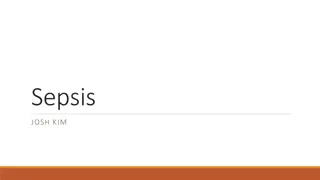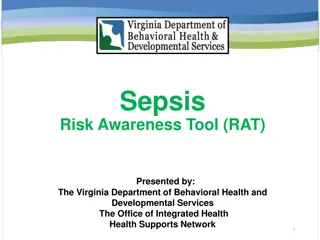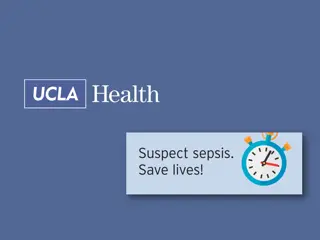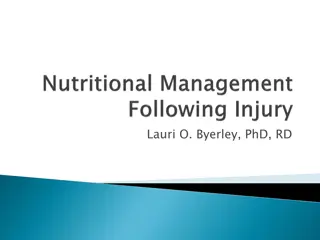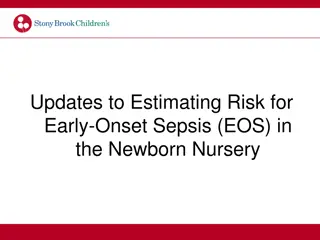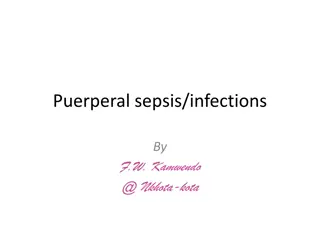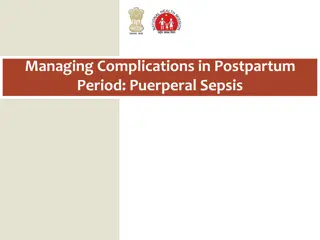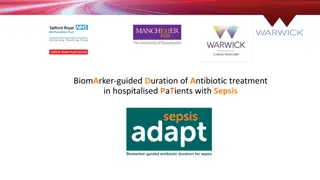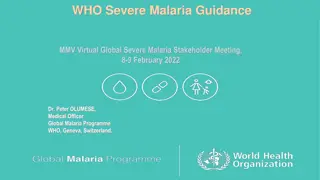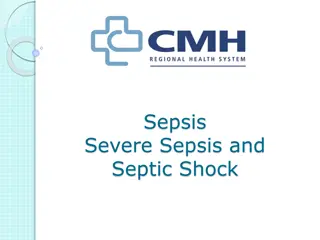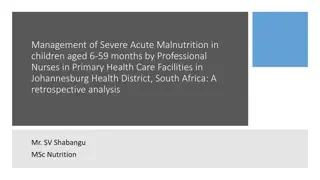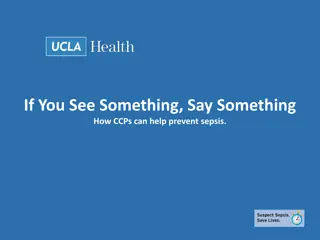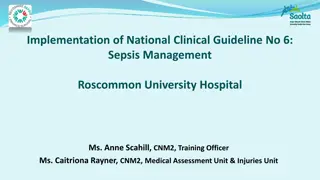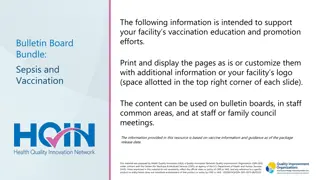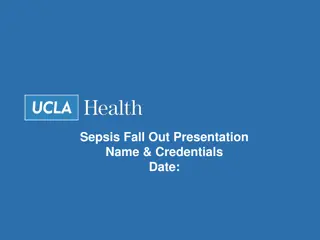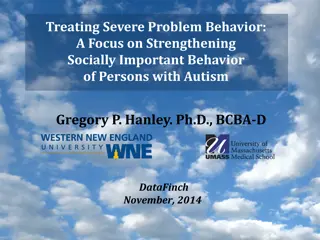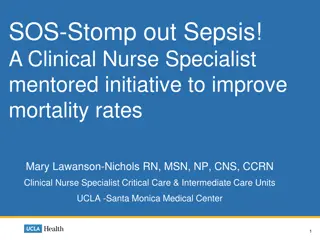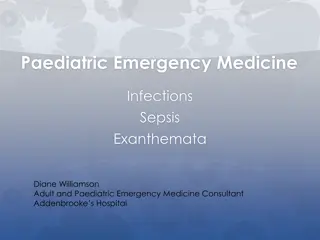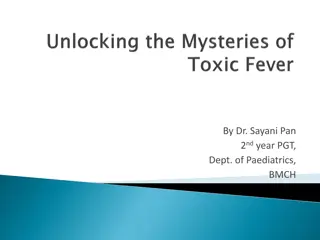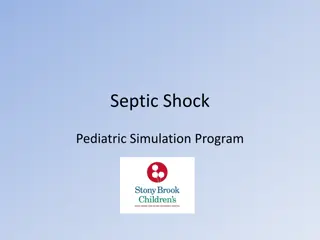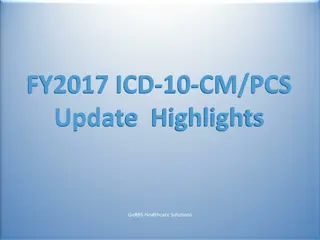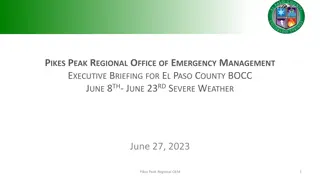DERMATOLOGY AND RHEUMATOLOGY
Staphylococcal Scalded Skin Syndrome (SSSS) is a serious condition characterized by red blistering skin resembling burns. It is caused by toxins from Staphylococcus aureus, leading to exfoliation of the skin. Common in infants, the elderly, and immunocompromised individuals, SSSS requires prompt dia
0 views • 89 slides
Opioid Use Disorder Treatment Guidelines 2024
The February 2024 NYSDOH AIDS Institute Clinical Guidelines Program focuses on assisting clinicians in engaging with patients about opioid use disorder (OUD) treatment goals, emphasizing overdose prevention, providing updated information on available treatment options, and offering recommendations f
2 views • 24 slides
Understanding Sepsis: Current Management Strategies and Global Efforts
Sepsis is a life-threatening infectious illness with significant global impact. The World Sepsis Declaration of 2012 underscores the need for improved recognition, prevention, and treatment strategies to address the high burden of sepsis worldwide. Efforts are being made to enhance management guidel
4 views • 118 slides
Treatment Supporter Scheme for Tuberculosis Preventive Treatment Beneficiaries
Treatment Supporter Scheme provides assistance to TPT beneficiaries in completing their treatment. Treatment Supporters can be various individuals including Medical Officers, MPWs, and community volunteers. Their role involves educating beneficiaries about TPT treatment, ensuring medication adherenc
1 views • 21 slides
Case Study: Sepsis Presentation and Management in Two Patients
Mrs. NP, a 55-year-old woman with a background of cirrhosis from heavy alcohol use, presented to the ED with symptoms suggestive of sepsis. Examination revealed a febrile state, elevated blood pressure, and altered mental status. Investigations were initiated to determine the cause, with differentia
2 views • 41 slides
Sepsis Risk Awareness Tool (RAT) Training Program Overview
The Sepsis Risk Awareness Tool (RAT) training program by The Virginia Department of Behavioral Health and Developmental Services aims to educate support coordinators, DSPs, and caregivers about the risk factors, signs, and symptoms of sepsis. It covers definitions, risk factors, signs, symptoms, dia
3 views • 22 slides
National Audit Results for Severe Sepsis and Septic Shock 2016/17
This presentation outlines the national results of a clinical audit conducted in 2016/17 regarding the management of severe sepsis and septic shock in Emergency Departments (EDs). The audit objectives include benchmarking current performance, facilitating national and peer comparisons, identifying a
0 views • 25 slides
Overview of Acute Pyelonephritis: Diagnosis, Treatment, and Epidemiology
Acute pyelonephritis is a serious bacterial infection of the kidneys, leading to complications such as renal scarring and sepsis. This overview covers key aspects including epidemiology, etiology, clinical presentations, and risk factors. Diagnosis, treatment, and prevention strategies are also disc
0 views • 18 slides
Collaborating to Combat Sepsis: Role of Respiratory Therapists
Sepsis is a critical condition involving infection and inflammation, where the body's response causes widespread symptoms. Learn about the continuum of sepsis, its pathophysiology, and respiratory warning signs. Respiratory therapists play a crucial role in identifying and managing sepsis, with stat
1 views • 14 slides
Implementation of UCLA Sepsis BPA Functionality & Careplan
The UCLA Sepsis Best Practice Alert (BPA) system aids in creating timely and effective care plans for patients diagnosed with sepsis. This comprehensive guide covers the activation triggers, BPA location, creation process, and elements of the Sepsis Careplan, emphasizing the importance of early inte
1 views • 16 slides
Importance of Nutrition in Patient Healing and Recovery
Gain insight into the critical role of nutrition in aiding patients in their recovery from injuries and enhancing their physical well-being post-injury. Explore the phases of injury, the physiological and metabolic impacts of each phase, and the corresponding nutritional support strategies. Delve in
1 views • 49 slides
Understanding Early-Onset Sepsis (EOS) Risk Factors and Management in Newborns
Neonatal Early-Onset Sepsis (EOS) is a rare but life-threatening condition primarily caused by Group B Streptococcus (GBS) or Escherichia coli. Recognizing risk factors such as maternal age, intrapartum fever, GBS colonization, and certain neonatal characteristics is crucial for timely evaluation an
0 views • 26 slides
Improving Sepsis Care Pathways: Rob's Story Highlights Areas for Enhancement
Rob's journey through a sub-optimal sepsis care pathway sheds light on crucial areas for improvement, such as insufficient education, poor communication, tracking issues, and serious implications leading to family distress and legal challenges. The story emphasizes the importance of timely and effec
1 views • 11 slides
Prevention and Management of Puerperal Sepsis and Infections
Puerperal sepsis and infections are serious conditions affecting women postpartum. Puerperal sepsis is characterized by specific symptoms, while puerperal infections are more general. Prevention includes antenatal care, strict intrapartum hygiene practices, and timely interventions. By following gui
2 views • 8 slides
Advanced Treatment Processes for Faecal Sludge Management
Treatment processes for faecal sludge management involve various stages including preliminary treatment, primary treatment, secondary treatment, and tertiary treatment. Each stage employs mechanical, biological, and chemical processes to separate, decompose, and remove contaminants from the sludge,
0 views • 7 slides
Managing Complications in Postpartum Period: Puerperal Sepsis Overview
Puerperal sepsis, a leading cause of maternal death, can be prevented through hygiene practices and early identification. Learn about the risk factors, diagnosis, and prevention strategies for maternal sepsis in the postpartum period.
3 views • 9 slides
Biomarker-Guided Antibiotic Duration in Sepsis Patients
This research focuses on evaluating the safety and efficacy of a biomarker-guided approach to determine the duration of antibiotic treatment in hospitalized adult patients with sepsis. The study involves a multi-centre randomized controlled trial to assess if a treatment protocol based on monitoring
0 views • 53 slides
Severe Malaria Treatment Guidelines by WHO
Severe malaria requires prompt diagnosis and treatment to prevent death and complications. The main focus is on achieving therapeutic concentrations of effective antimalarials quickly. Management involves clinical assessment, specific antimalarial treatment, addressing complications, and supportive
0 views • 18 slides
Managing Physical Health in Severe Mental Illness with a Focus on Diabetes
This educational material presents a comprehensive slide set designed to aid in the management of physical health in individuals with severe mental illness, focusing on diabetes. It includes insights on the challenges faced by healthcare professionals, learning objectives on diabetes management, and
0 views • 14 slides
Inpatient Management of Severe Acute Malnutrition Training Course 2011
This training course focuses on inpatient management of severe acute malnutrition, teaching procedures outlined in the national Community-Based Management of Severe Acute Malnutrition Guidelines. The training aims to reduce case fatality rates significantly and is designed for physicians, senior nur
0 views • 9 slides
Understanding Sepsis and Its Impact on Patient Care
Sepsis is a life-threatening condition resulting from the body's response to an infection, leading to shock, multiple organ failure, and potentially death if left untreated. Recognizing and treating sepsis promptly is crucial, as it has a high mortality rate and can have a significant impact on pati
1 views • 21 slides
Acute Malnutrition - Fluid Management and Treatment Overview
Acute malnutrition, particularly severe acute malnutrition (SAM), requires careful fluid management and a structured treatment approach involving stabilization, transition, and rehabilitation phases. This condition results from inadequate dietary intake or acute infections, leading to severe wasting
0 views • 23 slides
Management of Severe Acute Malnutrition in Children: A Retrospective Study in Johannesburg Health District
Severe Acute Malnutrition (SAM) in children aged 6-59 months is a critical public health concern in Johannesburg, South Africa. This study retrospectively analyzes the classification and management of SAM cases by professional nurses in primary health care facilities. The research highlights the imp
0 views • 14 slides
Understanding Severe Mental Illness in Mothers: Impacts and Support
Mothers with severe mental illnesses like Schizophrenia face unique challenges in parenting. Support from partners, family, and the community is crucial for their well-being. Despite the difficulties, with proper treatment and support, women with severe mental illnesses can effectively fulfill their
3 views • 23 slides
Changes to Transitional Severe Disability Premium Element in Universal Credit
Responding to a High Court judgment, changes are being made to the Transitional Severe Disability Premium Element in Universal Credit. Claimants qualifying for the Severe Disability Premium will receive additional amounts reflecting other disability premiums from legacy benefits. This adjustment aim
1 views • 7 slides
Aquatic Treatment Systems for Wastewater Reclamation and Reuse
In aquatic systems, wastewater treatment involves bacterial metabolism and sedimentation, with aquatic plants playing a role in improving treatment capabilities. This article discusses the functions of aquatic plants in treatment systems and the categories of wetlands used for wastewater treatment,
1 views • 15 slides
Understanding and Preventing Sepsis: Vital Information for Caregivers
Sepsis is a life-threatening condition caused by the body's response to infection. Learn about the symptoms, prevention strategies, and how to recognize and respond to sepsis in a healthcare setting. The importance of reporting vital signs accurately and understanding patient behavior is also highli
1 views • 9 slides
Implementation of Sepsis Management Guidelines at Roscommon University Hospital
Sepsis, a life-threatening condition, necessitates timely management for improved outcomes. Roscommon University Hospital implemented the Sepsis Screening Program in 2016 with the objective of standardizing practices, educating teams, and assessing outcomes. The initiative includes training, tool im
1 views • 18 slides
Importance of Vaccinations in Sepsis Prevention
Sepsis is a life-threatening response to infection that can lead to organ failure and death. Infection prevention through vaccinations is crucial to combat sepsis. Best practices include obtaining vaccination consent, offering education, and co-administering vaccines to older adults. Accessing vacci
1 views • 8 slides
Contrasting Pathways in Sepsis Care: Rob's Journey
Rob's story illustrates the stark contrast between sub-optimal and optimal pathways in managing sepsis. Delayed recognition and treatment in the sub-optimal pathway led to severe complications, whereas timely intervention in the optimal pathway resulted in improved outcomes. The importance of early
1 views • 7 slides
Sepsis Fallout Presentation - Managing Severe Sepsis and Septic Shock
This presentation template guides healthcare professionals on effectively managing severe sepsis and septic shock cases, emphasizing prompt recognition and appropriate interventions. It includes sections on patient background, sepsis criteria, treatment protocols, and debriefing discussions for cont
0 views • 7 slides
Treating Severe Problem Behavior in Autism: A Focus on Strengthening Socially Important Behavior
This document discusses a treatment approach for severe problem behavior in individuals with autism, focusing on enhancing socially significant behaviors. It outlines a Functional Assessment and Treatment Model with steps like Functional Analysis, Communication Training, Response Chaining, and Treat
0 views • 30 slides
Improving Mortality Rates in Sepsis Patients: A Clinical Nurse Specialist Initiative
Clinical Nurse Specialist, Mary Lawanson-Nichols, initiated a program at UCLA-Santa Monica Medical Center to reduce mortality rates in sepsis patients. By focusing on mentoring skills, leadership development for staff nurses, and examining influences on mortality, the program aims to make a signific
0 views • 24 slides
Paediatric Emergency Medicine Overview: Infections, Sepsis, Exanthemata, and Warning Signs
Paediatric emergency medicine involves assessing and managing various conditions in children, such as infections, sepsis, and exanthemata. This overview covers the evaluation of febrile children, warning signs indicating potential serious illness, and the importance of thorough examination and asses
0 views • 48 slides
Case Study: Infant with Persistent Fever and Cry
Aditi Malakar, a 2-month-old female infant, presented with a remittent fever persisting for 9 days unresponsive to antipyretics, along with persistent crying and decreased feeding for the last 2 days. She was referred to the hospital after being diagnosed with sepsis elsewhere. Aditi had a history o
0 views • 31 slides
Management Strategies for Pediatric Septic Shock Simulation Program
This content provides information on the management of sepsis, including recognition, supportive care, source control, antibiotics, and specific therapies. It emphasizes the importance of initial resuscitation goals, strategies involving fluid resuscitation, inotropic support, and timely administrat
0 views • 12 slides
Severe Weather Project Summary for Week 34
Week 34 of the Severe Weather Project focused on expanding development and evaluation of severe weather potential model guidance. The project aimed to develop experimental forecast tools for severe weather at Week 3-4 time range, utilizing a hybrid model and SCP (Supercell Composite Parameter). The
0 views • 21 slides
Updates and Highlights in FY2017 ICD-10-CM/PCS
In the FY2017 update of ICD-10-CM/PCS, significant changes have been made with new codes, updates, and deletions affecting coding diagnoses. The update includes coding highlights related to various conditions like bacteriuria, sepsis, pre-diabetes, and Zika virus. The Third International Consensus D
0 views • 30 slides
Interpreting the Use of 'Severe' in NPPF Impact Assessment
Understanding the term 'severe' in the National Planning Policy Framework (NPPF) for impact severity and its implications within the industry. The NPPF guidelines emphasize the importance of addressing significant impacts on the transport network and distinguishing between severe and significant imp
0 views • 14 slides
Severe Weather Executive Briefing - El Paso County - Pikes Peak Region
Severe weather events in the Pikes Peak region of El Paso County from June 8th to June 23rd, 2023, led to significant damages and emergency response activities. The area experienced above-average precipitation levels, severe thunderstorms, floods, and tornadoes, resulting in extensive damages to inf
0 views • 9 slides




